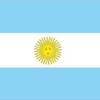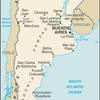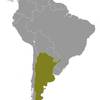Argentina [+]Compare [E]dit [H]istory
Aliases: Argentine Republic, Republica ArgentinaObject «Argentina» was created due to
Add new object to «Argentina» or move existing objects here.
Object «Argentina» has attributes [Show empty attributes][Hide empty attributes]
| Attribute | Value |
|---|---|
| Geography | |
| Area | 2,780,400 km² |
| Continent | South America |
| Land area | 2,736,690 km² |
| Water area | 43,710 km² |
| Land boundaries | 11,968 km |
| Border countries |
|
| Coastline | 4,989 km |
| Mean elevation | 595 m |
| Lowest point | -105 m |
| Highest point | 6,962 m |
| People | |
| Population | 45,479,118 |
| Official languages |
|
| Religion | Nominally Roman Catholic |
| Government | |
| Long country name | Argentine Republic |
| Short country name | Argentina |
| Long local name | Republica Argentina |
| Short local name | Argentina |
| Former name | Add |
| Government type | Presidential republic |
| Capital | Buenos Aires |
| Economy | |
| GDP (PPP) | 922,100,000,000 USD |
| GDP (OER) | 637,600,000,000 USD |
| GDP (real growth rate) | 2.9 % |
| GDP - per capita (PPP) | 20,900 USD |
| Gross national saving | 17.6 % of GDP |
| Labor force | 18,000,000 |
| Unemployment rate | 8.4 % |
| Population below poverty line | 25.7 % |
| Budget revenues | 120,600,000,000 USD |
| Budget expenditures | 158,600,000,000 USD |
| Military expenditures | 0.86 % of GDP |
| Taxes and other revenues | 18.9 % of GDP |
| Budget surplus or deficit | -6 % of GDP |
| Public debt | 57.6 % of GDP |
| Inflation rate | 25.7 % |
| Central bank discount rate | Add |
| Commercial bank prime lending rate | 26.58 % |
| Stock of narrow money | 62,610,000,000 USD |
| Stock of broad money | 62,610,000,000 USD |
| Stock of domestic credit | 219,400,000,000 USD |
| Market value of publicly traded shares | 56,130,000,000 USD |
| Current account balance | -31,320,000,000 USD |
| Exports | 58,450,000,000 USD |
| Imports | 63,970,000,000 USD |
| Reserves of foreign exchange and gold | 55,330,000,000 USD |
| External debt | 214,900,000,000 USD |
| National currency | Argentine pesos |
| National currency (code) | ARS |
| National currency (symbol) | $ |
| National currency rate to USD | 16.92 |
In 1816, the United Provinces of the Rio Plata declared their independence from Spain. After Bolivia, Paraguay, and Uruguay went their separate ways, the area that remained became Argentina. The country's population and culture were heavily shaped by immigrants from throughout Europe, with Italy and Spain providing the largest percentage of newcomers from 1860 to 1930. Up until about the mid-20th century, much of Argentina's history was dominated by periods of internal political unrest and conflict between civilian and military factions. After World War II, an era of Peronist populism and direct and indirect military interference in subsequent governments was followed by a military junta that took power in 1976. Democracy returned in 1983 after a failed bid to seize the Falkland Islands (Islas Malvinas) by force, and has persisted despite numerous challenges, the most formidable of which was a severe economic crisis in 2001-02 that led to violent public protests and the successive resignations of several presidents. The years 2003-15 saw Peronist rule by Nestor and Cristina FERNANDEZ de KIRCHNER, whose policies isolated Argentina and caused economic stagnation. With the election of Mauricio MACRI in November 2015, Argentina began a period of reform and international reintegration.
Similar objects
Most often compared with
Everyone can something to edit or add.
There were 3 edits, no edits waiting approval. Last edited by ciara11(4637), Sep 14, 2019 (one field was changed)
Help · Contact us · Disclaimer · Contributors · Developers · Donate


